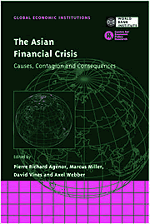Book contents
- Frontmatter
- Contents
- List of figures
- List of tables
- Preface
- List of conference participants
- Acknowledgements
- List of abbreviations and acronyms
- Introduction
- Part One General Accounts
- Part Two Theoretical Contributions
- Part Three Contagion
- 8 Contagion: monsoonal effects, spillovers and jumps between multiple equilibria
- Discussion
- 9 Contagion and trade: why are currency crises regional?
- Discussion
- 10 Competition, complementarity and contagion in East Asia
- Discussion
- Part Four Policy Responses
- Index
10 - Competition, complementarity and contagion in East Asia
from Part Three - Contagion
Published online by Cambridge University Press: 26 February 2010
- Frontmatter
- Contents
- List of figures
- List of tables
- Preface
- List of conference participants
- Acknowledgements
- List of abbreviations and acronyms
- Introduction
- Part One General Accounts
- Part Two Theoretical Contributions
- Part Three Contagion
- 8 Contagion: monsoonal effects, spillovers and jumps between multiple equilibria
- Discussion
- 9 Contagion and trade: why are currency crises regional?
- Discussion
- 10 Competition, complementarity and contagion in East Asia
- Discussion
- Part Four Policy Responses
- Index
Summary
Introduction
The magnitude and speed of the contagion effects that materialised in East Asia in the second half of 1997 has attracted much attention. This chapter asks to what extent the observed contagion may have had ‘real’ underpinnings, in the sense that the pattern of production, consumption and trade increased the vulnerability of East Asian countries to external shocks. In particular, we explore two major possibilities that are relevant in this connection: the ‘competition-cum-export similarity’ story or the ‘flying-geese-cum-Asia Inc.’ story which puts greater emphasis on regional integration and specialisation in complementary production structures.
The competition story posits that Asian economies have specialised in similar export bundles. In a longer-term perspective, the competition story hinges importantly on the emergence of China as a major exporter to world markets. An implication is that given a major devaluation by one country, others are forced to follow in order not to lose export market share. The complementarity story is based on the recent experience of Asianwide growth based on intra-regional trade and geographically cascading investments. In the past two decades, labour-intensive production gradually moved down from Japan, first to the Tigers – the ‘newly industrialised economies’ (NIEs) of Taiwan, Singapore, Hong Kong and Korea – then on to the Dragons (Thailand, Indonesia, Malaysia and the Philippines) and then to China and Vietnam. As a result East Asia became more integrated, its growth path generated by a constant process of industrial upgrading, in turn driven by a rapidly expanding stock of skills and real assets.
- Type
- Chapter
- Information
- The Asian Financial CrisisCauses, Contagion and Consequences, pp. 312 - 347Publisher: Cambridge University PressPrint publication year: 1999
- 8
- Cited by



